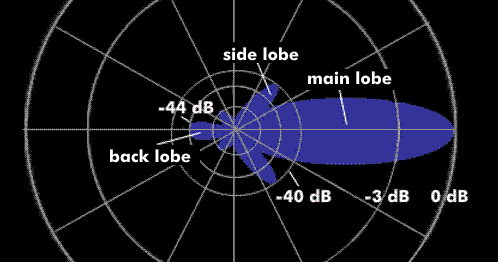radiation diagram
The radiation of electromagnetic waves and sound can be influenced directionally by technical and constructive measures. Such measures are used in the construction of antennas but also in the sound radiation of loudspeakers.
- The Radiation Diagram of antennas shows how electromagnetic waves propagate from the antenna in all directions, attenuating vertically and horizontally. In addition to the radiation and related field strength of transmitting antennas, the radiation pattern also illustrates the reception sensitivity for receiving antennas. The radiation pattern depends on the antenna design and can be uniform all around, as in the rod antenna, but it can also be directional or oriented to different planes of polarization, as in the dipole antenna, Yagi antenna, or parabolic antenna. Since the radiation characteristic is often pronounced in a lobe shape, it is also referred to as main and side lobes. obe In antennas with strong bundling, such as directional antennas, the beam angle of the radiation pattern is only a few degrees wide; in other cases, such as car antennas or rod antennas for WLANs, it is circular. In addition to the aperture angle, other important characteristics can be determined from the antenna pattern, such as the side lobe attenuation and the back lobe attenuation.In the antenna patterns, in addition to the main lobe or major lobe, several side lobes, the minor lobes, and a back lobe, the back lobe, can be recognized. The side lobe and back lobe affect the directivity, because they take energy away from the main lobe. Therefore, to characterize an antenna, the side lobe attenuation, the minor lobe ratio, and the back lobe attenuation are also specified. The minor lobe attenuation corresponds to the difference between the dB values of the main lobe and the minor lobe. If the main lobe has a 0 dB value and the side lobe is at -40 dB, then the side lobe attenuation is 40 dB. The same applies to the return loss, which is calculated from the dB value of the main lobe and that of the return lobe.
Optimized radiation patterns
In addition to the fixed radiation pattern, there are developments for intelligent beamforming to optimize the field strength in the receiving area, called beamforming. In this technique, individual antenna elements of an antenna array consisting of many antenna elements are electronically combined to form an antenna array. By combining a wide variety of antenna elements, the angle of incidence and the beam angle can be changed in stationary antenna systems. In addition, there are techniques with a fixed radiation pattern whose shaping is adapted to the reception conditions. Others work with a dynamic beam that is moved over the reception area. These techniques are referred to as beamforming.The radiation characteristics of sound waves Sound
waves radiated from loudspeakers are directionally sensitive. Their directional sensitivity depends on the ratio of the cone-shaped loudspeaker membrane to the radiated wavelength. If the wavelengths are short relative to the sound source, then the sound is radiated in an omnidirectional manner. In contrast, long-wave sound sources have a directional effect and bundle the sound. With reference to loudspeakers, it can generally be stated that high sound frequencies are emitted directionally, while lower frequencies are emitted non-directionally. A measure of the directional sensitivity is the degree of bundling. In practice, the frequency-dependent radiation characteristics of loudspeakers are important for the generation of surround sound and the associated positioning of the loudspeakers. There are certain types of loudspeakers, such as the funnel loudspeaker and the pressure chamber loudspeaker, in which the radiation characteristic is extremely directional.

